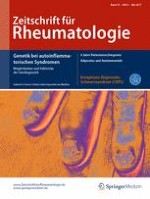Erschienen in:

10.04.2017 | Komplexes regionales Schmerzsyndrom | CME
Komplexes regionales Schmerzsyndrom
verfasst von:
PD Dr. Dr. F. Brunner
Erschienen in:
Zeitschrift für Rheumatologie
|
Ausgabe 4/2017
Einloggen, um Zugang zu erhalten
Zusammenfassung
Mit dem Begriff des komplexen regionalen Schmerzsyndroms (CRPS) werden verschiedene schmerzhafte Zustände zusammengefasst, die typischerweise nach einem auslösenden Ereignis distal an einer Extremität auftreten. Charakteristischerweise übersteigen die Dauer und die Intensität der Beschwerden den normalerweise zu erwartenden Verlauf. Klinisch manifestiert sich das CRPS als bunter Symptomkomplex, bestehend aus sensiblen, vasomotorischen, sudomotorischen, motorischen und trophischen Störungen. Beim CRPS handelt es sich grundsätzlich um eine klinische Diagnose unter Berücksichtigung der modifizierten Budapest-Kriterien. In der Frühphase ist aus differenzialdiagnostischer Sicht eine Abklärung hinsichtlich eines Infektes, einer neurogenen Kompressionssymptomatik und entzündlichen Erkrankungen essenziell. Benigne Verläufe sind bekannt, viele Patienten entwickeln jedoch chronische Verläufe mit persistierenden Beschwerden auch nach 1 Jahr. Die Therapie basiert auf medikamentösen, interventionellen, physio- bzw. ergotherapeutischen und psychiatrischen Behandlungsoptionen.